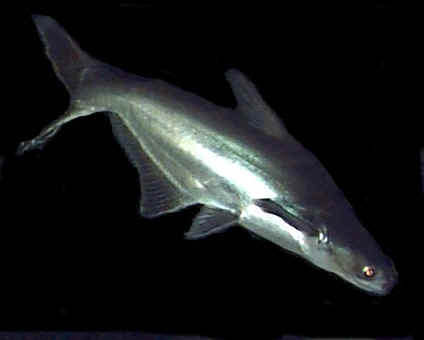Catfish - Pangasius
Iridescent Shark, Shark Catfish Scientific Name: Pangasius sutchi
Fri, 4th April, 2025 - 4:18 pm GMT
Sponsor Ads:

Alternative Name
Iridescent Shark, Shark Catfish Scientific Name: Pangasius sutchiBasic Info
The Iridescent Shark gets its name from the fact that it changes colors. At maturity, the Iridescent Shark can grow to be a full meter in length, which is why they need to be kept in extremely large aquariums.
Health
Iridescent Sharks are sensitive fish and need lots of special attention. They become startled easily by any abrupt action in their environment or tapping on the tank. When startled, they will either play dead, or go into a swimming fit, which usually results in them hitting the glass walls. Iridescent Sharks will thrive in a narrow temperature range, from 72 to 79 degrees fahrenheit, and need a neutral pH, ranging from six and a half to seven and a half. They are also overly susceptible to disease. Iridescent Sharks are omnivores, but as they grow old, they lose their teeth, making them more of a vegetarian. When they are young, Irridiscent Sharks should be fed live foods, including blood worms, glass worms, brine shrimp and tubifex worms. Also, they will eat frozen beef heart, plankton, and worms. As they mature, their diet should lean towards vegetables, flake foods, algae discs, and food sticks. Iridescent Sharks will also eat small fish that can fit into their mouths. Breeding Iridescent Sharks do not breed in aquariums, but they will breed in large ponds. There are no known distinguishing sexual features of the Iridescent Shark; hence, the two sexes are inseparable.Habitat
Fresh water fishBehavior
The Iridescent Shark is a great fish for any dedicated and experienced aquarist. It is very intelligent, outgoing, friendly, and beautiful. Caretakers have reported the Iridescent Shark coming to the surface of its tank to be petted. Due to their large size and relative sensitivity, the Iridescent Shark is not recommended for beginning and small-scale aquarist. Iridescent sharks are very friendly and make good community fish, as long as they are kept with similar sized fish. When they are young, they like to form small schools, if several are kept together. When they mature, they are not aggressive and will generally keep to themselves. They actively swim, and are known to occasionally make croaking noises. If the Iridescent Shark becomes frightened, it will play dead until it feels it is safe. Iridescent Sharks need to be kept in tanks with a several hundred-gallon capacity, as they grow very large. Their tanks should be lightly decorated with rocks and plants. Live plants may used, but the Iridescent Shark might eat them.Origin
ThailandHistory
The Iridescent Shark, also known as the Pangasius Catfish or Pangasius sutchi, is from Thailand.Common Foods
N/ASponsor Ads:
Those things are better which are perfected by Nature than those which are finished by art. -- Unknown
Catfish - Pangasius
Coded by: BGID® | ALL RIGHTS RESERVED Copyright © 2000-2025
Disclaimer | Privacy | Report Errors / Contact | Credits


 Preparing For China. China is growing their military. China Military Technology - can it keep up with the US?
Preparing For China. China is growing their military. China Military Technology - can it keep up with the US?  versus
versus 

 versus
versus 
 This Thread is about the North Korean Military itself - the kind of army, navy, and air force they have.
This Thread is about the North Korean Military itself - the kind of army, navy, and air force they have. 
 versus
versus 
 versus
versus  versus
versus